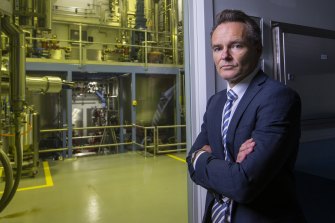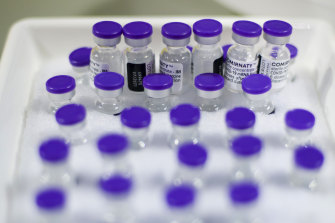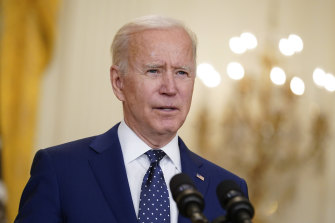By Anne Hyland
In Melbourne, a manufacturing facility that could potentially be repurposed to help produce a COVID-19 vaccine sits idle. The facility – owned by pharmaceutical company IDT Australia – was opened in 2008 by then-premier John Brumby, and among the types of products made on its production line were antibiotics. But the facility fell into disuse as it became cheaper to manufacture medicines offshore.
In March, the federal Health Department asked IDT to conduct a feasibility assessment to determine if its facility could be used “to supplement the production capacity for a COVID-19 vaccine”. The answer was yes. IDT facilities could be used to produce a vaccine, including an mRNA vaccine.
“We have existing facilities which could potentially be deployed to manufacture mRNA vaccines,” says David Sparling, chief executive of pharmaceutical company IDT Australia.Credit:Wayne Taylor.
Currently, CSL is the only manufacturer of a COVID-19 vaccine in Australia, delivering the AstraZeneca vaccine, of which Australia had agreed to buy almost 53.8 million doses. However, that vaccine has now been restricted to people aged over 50 after concerns of a rare blood clot side effect.
The AstraZeneca vaccine has been widely administered in the UK but not approved in the US, which has primarily been deploying mRNA vaccines from Pfizer and Moderna. There is growing evidence that the mRNA vaccines, which contain genetic code from a virus rather than the virus itself, are much easier to reconfigure to cover new viral variants of COVID-19 than the conventional inoculations such as AstraZeneca’s. The mRNA vaccines also have the highest efficacy rates in fighting COVID-19.
The Victorian government announced last week that it would invest $50 million to fund the manufacturing of mRNA vaccines. While Pfizer and Moderna have commercially available mRNA vaccines, Australian universities, such as Monash, have also developed mRNA COVID-19 vaccines, which could be ready for manufacture and clinical trials if more local production facilities were made available.
David Sparling, IDT’s chief executive, said his company was keen to be involved in the production of COVID-19 vaccines in Australia and welcomed the Victorian government’s announcement. “This is a great initiative,” he told The Sydney Morning Herald and The Age. “Australia has world-class mRNA researchers and IDT Australia could play a role, as we have existing facilities which could potentially be deployed to manufacture cGMP mRNA vaccines and treatments.”
Sparling declined to comment about the size of IDT’s facility. Pharmaceutical industry sources, however, say IDT’s plant has a production line similar in size to that of CSL’s, and would only require minor repurposing. IDT’s production line is understood to be currently set up for 20mm vials, while an mRNA vaccine requires 2mm vials.
The Victorian government’s announcement has prompted an assessment of other manufacturing facilities in that state that could be repurposed, with speculation also falling on a GSK Australia facility, which had been marked for closure at the end of next year.
The move by the Victorian government to develop a manufacturing facility for mRNA vaccines comes as the timetable to vaccinate all Australians continues to slip, as it has also in some other countries. The reasons for the delay include unexpected safety concerns with vaccines and bottlenecks in supply.
Vials of Pfizer’s COVID-19 vaccine. Pfizer said it is not in discussions to manufacture its vaccine in Australia. Credit:Bloomberg
The federal government has now said Australians aged under 50 will receive the Pfizer vaccine by year-end, of which it’s committed to buying 40 million doses.
Pfizer’s mRNA vaccine is flown in weekly to Australia but the company won’t disclose how many doses are in those deliveries. A company spokesperson said Pfizer was confident of delivering those 40 million doses by the end of 2021. “We can confirm second-quarter, third-quarter and fourth-quarter 2021 deliveries to Australia remain on track and continue to progress in line with our weekly delivery schedule.”
The spokesperson said Pfizer was not in discussion with Australian companies on mRNA manufacturing, and remained focused on its hubs in Europe and the United States. “At this time we are not in discussions for any additional manufacturing outside these established supply lines for this vaccine,” the spokesperson said. “Once the pandemic supply phase is over, and we enter a phase of regular supplies, Pfizer will certainly evaluate all additional opportunities available.”
The slow pace of inoculation in Australia and globally has prompted concerns the battle against the pandemic and the economic effects of it will stretch beyond 2022. A report by investment bank UBS estimates that 48.7 per cent of the world population will be inoculated by the end of this year.
In Australia, Professor Colin Pouton of Monash University’s Institute of Pharmaceutical Sciences and his team have developed three mRNA COVID-19 vaccine candidates. He has argued strongly for onshore production, as has Professor John Shine, president of the Australian Academy of Science. Pouton has been advising the Victorian government on its manufacturing mRNA plans.
The ability to control the supply of critical vaccines would give Australia greater flexibility in adapting to potentially new strains of COVID-19 and responding to other emerging viruses in the future. It would also position the federal government to better assist neighbouring countries such as Papua New Guinea, where COVID-19 cases are surging.
The fragility in the global supply of pharmaceutical products was highlighted in a Productivity Commission report released last month. It noted the problem with pharmaceuticals was that they often come from a single foreign source.
Australia, according to the Institute for Integrated Economic Research, imports 90 per cent of its medicines, which it had argued has left the country vulnerable. The IIER notes that while offshoring of pharmaceutical manufacturing has delivered cheaper medicines for Australia, it has come at a cost and this was demonstrated when COVID-19 hit.
As the pandemic swept the globe last year, many countries stockpiled medicines and equipment, disrupting supply chains and causing shortages in Australia of critical medicines. The disruption continues, with export restrictions imposed on vaccines and the raw materials to make vaccines.
The US Defence Production Act, invoked by President Joe Biden, can also hinder the export of raw materials and equipment used in vaccine production.Credit:AP
In the US, the Biden administration invoked the Defence Production Act earlier this year, which allowed it to impose some control over private-sector supply of critical equipment and material, and direct it towards bolstering domestic vaccine development and supply. The US Defence Production Act can also hinder the export of such materials and equipment.
The New York Times reported that Pfizer has benefited from the US Defence Production Act.
The European Commission also imposed export controls, which allowed EU countries or the Commission to block shipments of vaccines made by companies that were failing to fulfil their contractual obligations to the EU.
Vaccine nationalism is a problem that isn’t going to be resolved soon. And even as the one billionth dose of COVID-19 vaccine was produced this month, global demand remains huge: 9.5 billion doses, according to UBS. Australia, with almost no COVID-19 cases, is unlikely to be put at the top of the queue for supply of vaccines from offshore.
Get our Coronavirus Update newsletter
Stay across the news you need to know related to the pandemic. Sent Monday and Thursday. Sign up here.
Most Viewed in National
Source: Read Full Article










